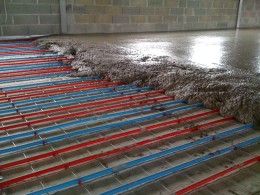
Ah, storage heaters. The silent, mysterious magicians of the heating world. You never hear anyone raving about them as they do with smart thermostats or underfloor heating. But the truth is, storage heaters are a reliable and affordable option for heating your home, especially in the UK, where the weather can be as unpredictable as a reality TV show. So, let’s answer the burning question:
How do storage heaters work?
Well, let me start by asking you a question. Have you ever cooked a meal in a slow cooker? If you have, you’re already halfway there to understand how storage heaters work. Like a slow cooker, a storage heater stores heat during the night (when electricity is cheaper) and releases it during the day, keeping your home toasty warm without breaking the bank.
But how does it store the heat? With some good old-fashioned science, that’s how! Inside the heater are clay or ceramic bricks that act as heat stores. These bricks absorb the heat the electricity produces and store it until it’s time to release it. Genius, right?
Now, let’s take a closer look at the components that make up a storage heater:
- Bricks: These are the core of the storage heater, made of ceramic that can absorb and store vast amounts of heat.
- Element: This is what heats the bricks. As electricity passes through it, the element heats up, and the bricks soak up that heat like a sponge in water.
- Thermostat: It regulates the temperature inside the storage heater. When the bricks reach the desired temperature, the thermostat switches off the heating element.
- Vents: These vents allow the heat to escape from the storage heater, warming your cold toes and bringing joy to your heart.
You might wonder, “But how do I control when it releases the heat?”
Good question! Most storage heaters have a simple dial or switch that lets you control the output. So, if you’re feeling chilly in the morning, you can turn it up; if you’re feeling too warm in the afternoon, you can turn it down. Easy peasy.
The benefits and drawbacks of storage heaters
One thing to remember is that storage heaters work best in well-insulated homes. If your house is draughty or poorly insulated, you’ll find that the heat escapes quickly, and you’ll be left shivering. So, before investing in a storage heater, ensure you have good insulation in place.
Another thing to consider is the size of the heater. You don’t need a big, bulky heater in a small room. A small, compact model will do just fine. But if you have a large room or an open-plan living space, you’ll need a bigger heater to ensure evenly distributed heat.
Benefits of Storage Heaters:
1. Cost-effective operation: One of the primary advantages of storage heaters is their cost-effectiveness. By utilizing cheaper off-peak electricity rates, typically at night, they can store heat when demand is low and release it during the day when electricity prices are higher. This can lead to potential cost savings on electricity bills, especially in areas with time-of-use tariffs.
2. Simple and easy installation: Storage heaters are relatively easier to install than other heating systems. They do not require complex ductwork or pipework, making them a convenient choice, especially in existing buildings. This simplicity can save both time and money during the installation process.
3. Reduced maintenance requirements: Storage heaters have fewer moving parts than other heating systems, such as boilers or furnaces. As a result, they generally require less maintenance, which can translate into fewer expenses and less hassle for homeowners.
4. Silent operation: Storage heaters operate silently since they do not involve fans or pumps. This can particularly benefit individuals who value a quiet and peaceful living environment.
Drawbacks of Storage Heaters:
1. Lack of temperature control: One significant drawback of storage heaters is their limited ability to control room temperature accurately. Once the heat is released, it is challenging to adjust the output. This can lead to overheating or insufficient warmth in certain situations, making it difficult to maintain a consistent and comfortable indoor environment.
2. Inflexibility and discomfort during transitional weather: Storage heaters are designed to release heat gradually over an extended period, usually throughout the day. This approach may work well during colder seasons but can be problematic during transitional weather when temperature fluctuations are typical. Users may experience discomfort due to overheating or inadequate heat output.
3. High energy consumption: Although storage heaters take advantage of off-peak electricity rates, they can still consume significant energy. The need to store heat during the night can result in higher electricity usage, especially if the insulation of the building is inadequate. In regions where off-peak tariffs are not available, or electricity prices are generally high, the cost savings associated with storage heaters may be limited.
4. Limited control and responsiveness: Compared to modern heating systems, storage heaters often lack advanced controls and programmability. This means users have limited options for fine-tuning the heating schedule and adapting to changing requirements. They may also struggle to respond quickly to sudden weather changes or unexpected temperature adjustments.
Considering these benefits and drawbacks is essential when deciding whether storage heaters suit a particular situation. Factors such as climate, energy costs, building insulation, and personal preferences should all be considered before deciding.
So, there you have it, folks! Storage heaters may not be the most glamorous heating option, but they’re reliable and effective. And who knows, you might find they’re the perfect fit for your home.




 POSTED BY
POSTED BY 

